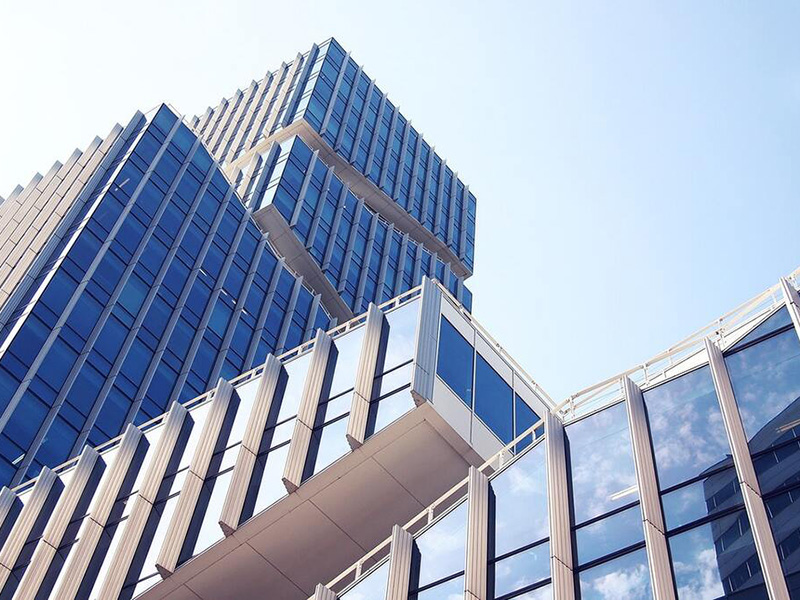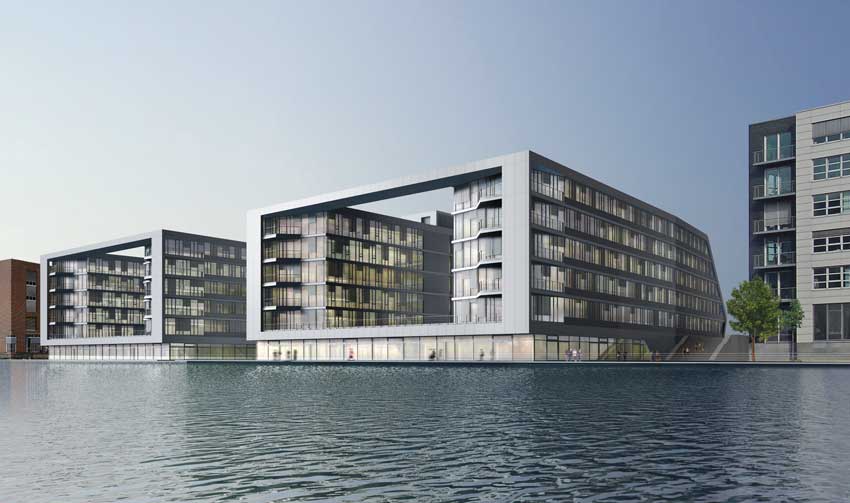
|
| The H2 Office in Duisburg was awarded the Gold Certificate from the German Sustainable Building Council in the New Office and Administration Building category. Photo: Copyright: Duisburg Orco Germany |
The consequences of continuing climate change are becoming ever more frequent and obvious. Melting glaciers, droughts of the kind never seen before, destructive flooding – the media reports daily on the consequences of mankind's massive impact on the environment. Climate change cannot be stopped but it must be slowed down. For this far-reaching international measures for climate protection are required.
Specifically, building construction can and indeed must make a significant contribution here. According to EU statistics, the 160 million buildings across the EU are still responsible for 40% of Europe's final-energy consumption levels. These buildings generate 36% of carbon dioxide emissions (CO2). The huge impact of the construction industry on natural resources is evidenced by further figures from Germany. The Federal Ministry of Transport, Building and Urban Affairs (BMVBS) approximates that 50% of the country's national raw material requirements are accounted for by building construction and conversion. Some 60% of the waste materials produced in the Federal Republic arise from building construction.
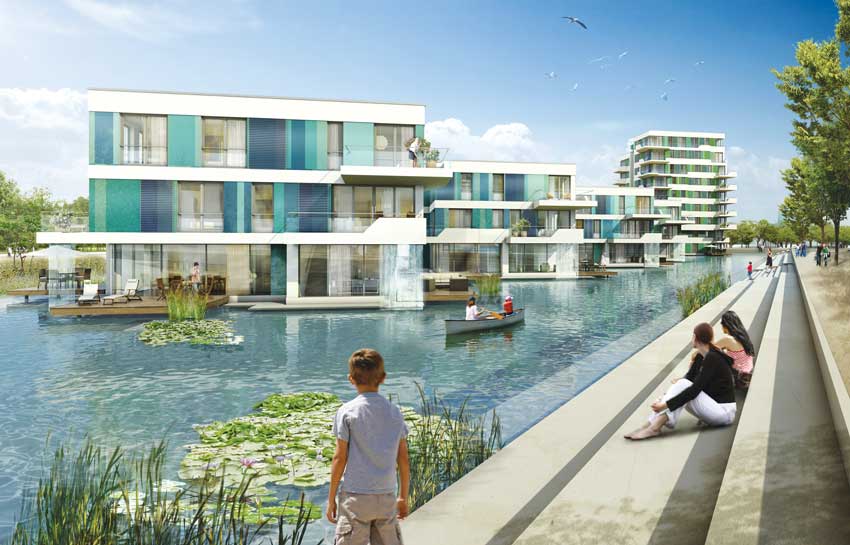
|
| The residential island park project “Projekt Waterhouses – Wohnen am Inselpark” in Hamburg was given DGNB Gold Pre-Certification in the “New Residential Building” category. Pre-certification means buildings can be optimised and better marketed already in the planning phase. Photo: HOCHTIEF Solutions AG, Design: moka-Studio |
Central Task for the Future
In view of the scale of this situation, it becomes clear that sustainability will become a central task for the future in the construction industry. An example from forestry can quickly serve as an example to demonstrate the importance of sustainability. Here the sustainability principle means only felling as many trees as can be replanted. In the construction industry, the term is defined in a wider sense and also includes ecological, economic and socio-cultural aspects.For the construction industry to make building operations sustainable and introduce recycling management, it needs new planning and implementation systems. "Green Building" is in ever greater demand and has long since been a key aspect in the investment strategies of the finance and property development sectors. Buildings built, run and dismantled in a verifiably energy-efficient and also resource-saving manner ensure high value retention making them easier to rent and sell.
The trend towards sustainable building is also being promoted at policy-making level. Annex I of the European Regulation on the Marketing of Construction Products introduced in spring 2011 includes sustainability as the seventh basic requirement for construction works. This requirement contains criteria such as the durability and recyclability of building works and building materials as well as the use of environmentally compatible raw and secondary materials in construction works. By 1 July 2013 EU manufacturers of construction products must disclose relevant data here as part of their performance declarations. However, it has not yet been finalised how exactly the environmental information is to be declared.
Sustainability certification for buildings is still carried out on a voluntary basis. However, interest in this from the property market is growing and policy-makers are pushing this trend forward. It is likely this voluntary basis will become compulsory in the long-term.
Sustainability Certifications are in Demand
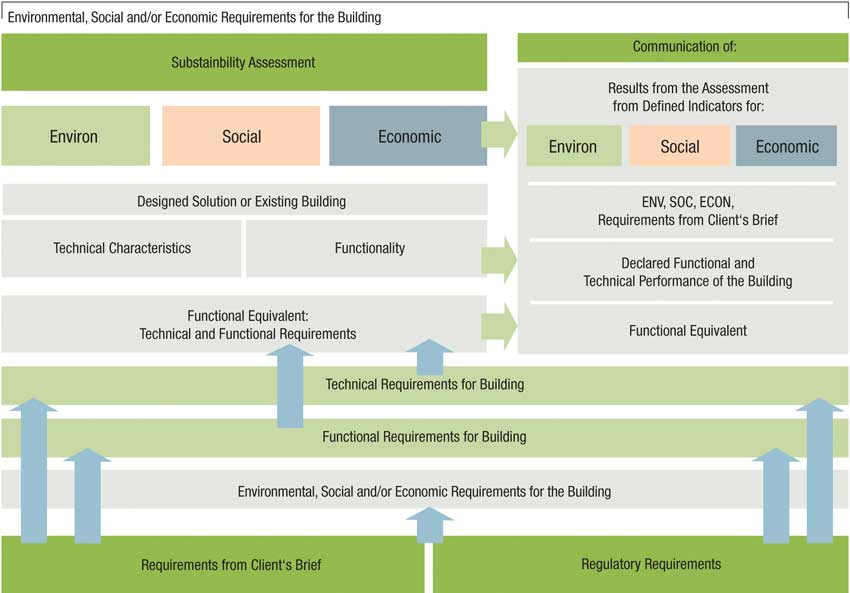
|
| Sustainability Assessment Concept for Buildings, (EN 15643-1:2010)Photo: IBU |
As none of the international systems met the German building ministry's high rating requirements Germany, with technical support from research and business developed its own rating system for sustainable building – the "Bewertungssystem Nachhaltiges Bauen" (BNB). All new federal and state office and administration buildings are already now certified according to the "Sustainable Building" guidelines under the BNB system. It is also already planned for these guidelines to be extended for residential buildings.
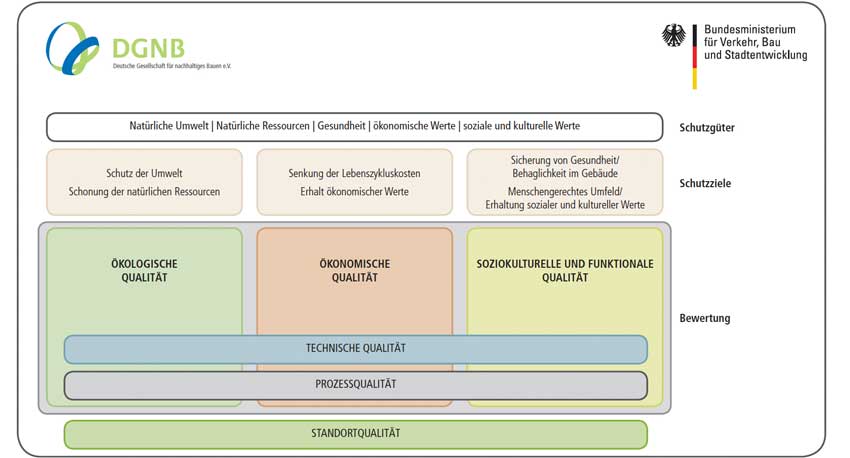
|
| Structure of the German Certification System Photo: BMVBS, DGNB, IBU Chart available in German only. |
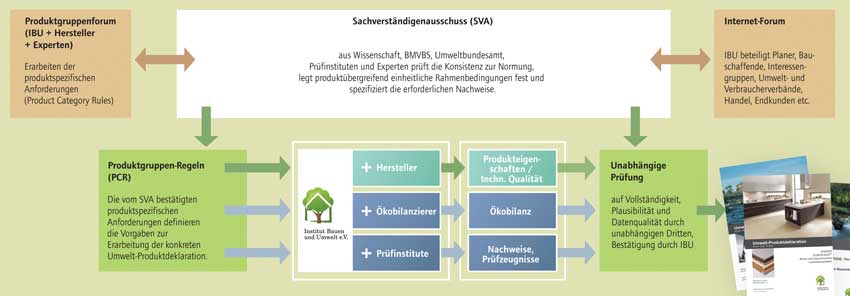
|
| Procedure Flowchart for the EPD Programme from the building and environment body Institut Bauen und Umwelt e.V. (IBU) Photo: IBU Chart available in German only.. |
Environmental Product Declarations provide Basic Data
Certification of building sustainability requires the manufacturers of construction materials to make available information on their products. Environmental Product Declarations (EPDs) play a key role here. Within this context the European Regulation on Construction Products demands that: "For the assessment of the sustainable use of resources and of the impact of construction works on the environment; Environmental Product Declarations should be used when available." The normative basis for environmental production declarations (Type III Eco-Label) are ISO 14025 or prEN 15804. These set out the calculation and assessment procedures to be used to analyse the impact of construction products on air, soil and water during their entire life cycle (life cycle assessment).When compiling an EPD, it is only compulsory to state details on the manufacturing life cycle. The other life cycle phases (use, dismantling and recycling) can, but do not have to, be taken into consideration. However, both the BNB and the DGNB certification systems demand consideration of all phases. The window technology centre Institut für Fenstertechnik Rosenheim (ift) points out here that especially with long-lasting exterior building components like glazing, windows and façades environmental impact during their very long useful life is significantly higher than during the production process. This is why the institute recommends manufacturers have the impact across the entire product life cycle assessed.
The EPDs are issued by publicly recognised bodies. Currently, in Germany, these are the Institut Bauen und Umwelt e.V. (IBU), a grouping of construction product manufacturers, and the ift Rosenheim. However, it is anticipated that further institutions will be established on the market. Environmental Product Declarations can be prepared for an individual manufacturer, several manufacturers joining together or an entire association.

|
| The chart shows the life cycle of a construction product. The phases included in the sustainability assessment depend on the certification system selected. Photo: IBU |
Solution for Glass, Windows and Façades
For companies the path to making an EPD is relatively convenient via sector-based solutions. For instance, in the research project "EPDs for Transparent Construction Elements" the research bodies Institut für Fenstertechnik, Institut für Bauen und Umwelt and PE International GmbH along with trade associations Flachglas (BF), Fenster+Fassade (VFF), Kunststoff-Erzeugnisse (QKE) und Schloss + Beschlag (FV S+B) have developed EPDs for plastic, aluminium and wooden windows as well as for glass in the construction industry.Dipl.-Ing. Jochen Grönegräs, Managing Director of BF Flachglas, an association grouping German flat glass manufacturers and processors, does not believe creating quality competition between companies on the basis of EPDs makes sense: "In our view, Environmental Product Declarations are not a suitable method for differentiating products on the market. Here a sector-based solution makes more sense. For this reason, the associations Bundesverband Flachglas, Fenster+Fassade and the ift have joined together to initiate the research project 'EPDs for Transparent Construction Elements." The association was still in discussion with the ift and the IBU as to how the project should apply to manufacturers' EPDs, said Grönegräs.
On the basis of project results, the ift and PE International already this year wish to publish an online tool with easy-to-use standard EPDs for all product manufacturers. However, the sector-based solution does have one disadvantage. It concentrates on necessary minimum specifications. Individual features such as the use of green electricity or particularly eco-friendly logistics are not taken into consideration here. However, for Jochen Grönegräs this is not an obstacle for a joint approach as ultimately every member could also make an individual EPD for their products in addition to the sector-based solution.
A further motivation for flat glass manufacturers to carry out the joint research project was the chance to have their say in the content of the "Ökobau.dat" database that is already now available for product data acquisition. Commenting on this Grönegräs said: "This means the quality of the data on our glass products made available for download from this portal now lies in our hands."
This is an understandable motivation as the quality of construction glass products plays a decisive role in the implementation of sustainability criteria. Highly functional solar control, heat protection and sound insulation glass also contributes to good energy-balance results, as do building-integrated photovoltaics. glasstec in Düsseldorf will offer an excellent overview of the already advanced developments in this key supply sector from 23 to 26 October 2012. This, the most important international glass trade fair, will be host to exhibitors from throughout the world showcasing their product solutions for sustainable construction. Energy efficiency and sustainability will also play a key role at the innovative show "glass technology live" and at the "FassadenCenter" which groups together renowned companies plus key associations concerned with the topic of building envelopes. The congress programme accompanying the trade fair also offers a great opportunity for exchanging ideas and discussion.










